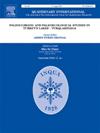在捷克共和国波希米亚的一个沼泽遗址,对一个独特的青铜器时代的黍和人类遗骸的多代理-代理调查
IF 1.8
3区 地球科学
Q3 GEOGRAPHY, PHYSICAL
引用次数: 0
摘要
在捷克共和国Zahájí遗址的湿地中发现的糜子植物(Panicum miliaceum)的沉积属于中欧最古老的谷子发现。它出现在一个位于人口密集的低地地区的小溪谷的一个新形成的浅湖中,伴随着一个奇怪的人类指甲的发现(都可以追溯到公元前1400-1300年);它们在同一层中的共同存在并非偶然。尽管从多种代理调查(如沉积物岩石地层学、地质和水化学、花粉、植物大化石、水生无脊椎动物和有机残留物分析,以及小米和指甲的aDNA)中收集了丰富的背景信息,但对这一发现的考古解释极具挑战性,因为迄今为止在欧洲/更广泛的背景下还没有已知的类比。我们提出了一些可能发生的情景,包括某些形式的仪式行为或对小米的崇敬,小米是一种最近才在公元前2000年中期从东南亚迅速向西迁移到中欧的作物。本文章由计算机程序翻译,如有差异,请以英文原文为准。
Multiproxy-proxy investigation of a unique Bronze Age deposit of broomcorn millet and human remains at a bog site in Bohemia, Czech Republic
The deposition of broomcorn millet plants (Panicum miliaceum), found in the wetland of the Zahájí site in the Czech Republic, belongs to the oldest millet findings in Central Europe. Its appearance in a newly formed shallow lake in a small brook valley located in the populated lowland area was accompanied by a curious finding of a human fingernail (both dated ca. 1400-1300 BC); their joint presence in the same layer does not appear accidental. Although a wealth of contextual information has been gleaned from multi-proxy investigations (such as sediment lithostratigraphy, geo and water chemistry, pollen, plant macrofossils, aquatic invertebrae and organic residua analyses, and aDNA of millet and the fingernail), archaeological interpretation of the find is highly challenging having no known analogies in the European/wider context so far. We present some possible scenarios of what might have happened, including certain forms of ritual behaviour or reverence for millet, a crop that has only recently spread in central Europe around the mid-2nd millennium BC following its rapid westward migration from southeastern Asia.
求助全文
通过发布文献求助,成功后即可免费获取论文全文。
去求助
来源期刊

Quaternary International
地学-地球科学综合
CiteScore
5.60
自引率
4.50%
发文量
336
审稿时长
3 months
期刊介绍:
Quaternary International is the official journal of the International Union for Quaternary Research. The objectives are to publish a high quality scientific journal under the auspices of the premier Quaternary association that reflects the interdisciplinary nature of INQUA and records recent advances in Quaternary science that appeal to a wide audience.
This series will encompass all the full spectrum of the physical and natural sciences that are commonly employed in solving Quaternary problems. The policy is to publish peer refereed collected research papers from symposia, workshops and meetings sponsored by INQUA. In addition, other organizations may request publication of their collected works pertaining to the Quaternary.
 求助内容:
求助内容: 应助结果提醒方式:
应助结果提醒方式:


